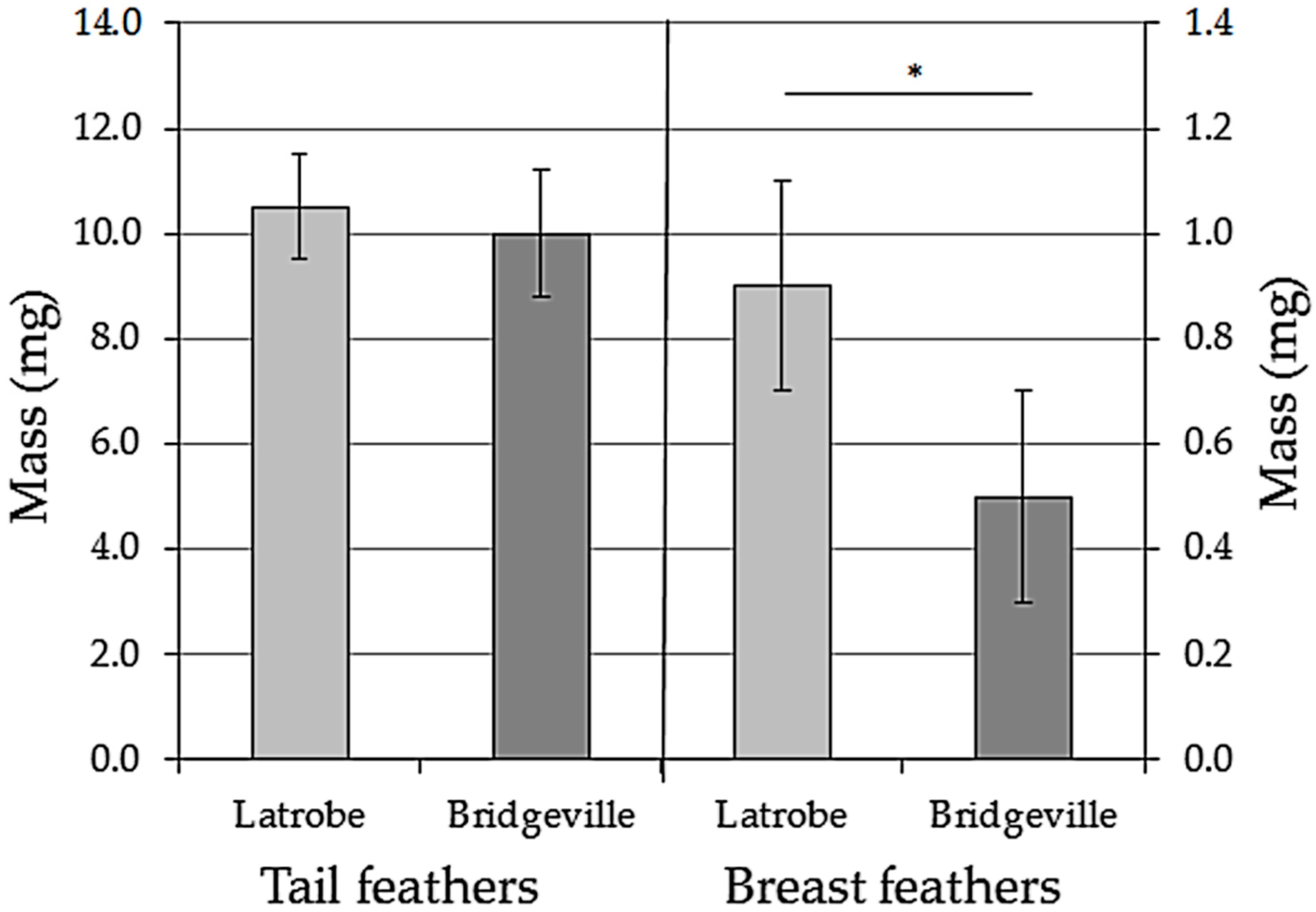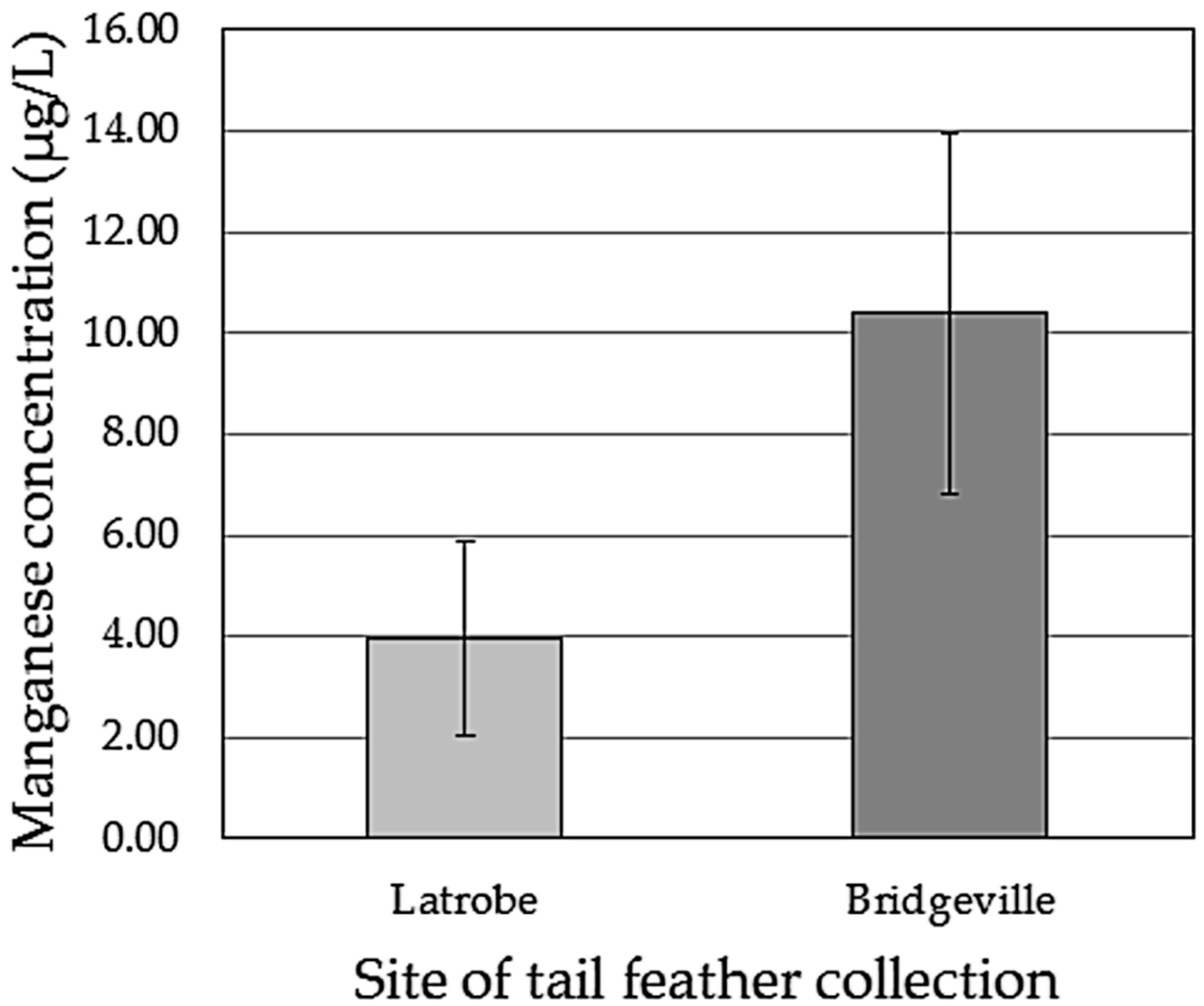Concentrations of Manganese in Tufted Titmouse Feathers near Metal Processing Plants
Abstract
Simple Summary
Abstract
1. Introduction
2. Materials and Methods
2.1. Study Species
2.2. Site Descriptions
2.3. Feather Sampling and Morphometrics
2.4. Feather Preprocessing
2.5. Microwave Plasma-Atomic Emission Spectrometry
2.6. Statistical Analyses
3. Results
4. Discussion
Supplementary Materials
Author Contributions
Funding
Institutional Review Board Statement
Data Availability Statement
Acknowledgments
Conflicts of Interest
References
- Muhawenimana, F. Essential and Non-Essential Elements in Feathers of Snow Bunting Nestlings of Longyearbyen and Adventdalen—Svalbard 2016. Master’s Thesis, Norwegian University of Science and Technology, Trondheim, Norway, 2016. [Google Scholar]
- Carson, R. Silent Spring; Penguin: London, UK, 2002. [Google Scholar]
- Pollock, C. The canary in the coal mine. J. Avian Med. Surg. 2016, 30, 386–391. [Google Scholar] [CrossRef] [PubMed]
- Burger, J.; Gochfeld, M. Comparison of arsenic, cadmium, chromium, lead, manganese, mercury and selenium in feathers in Bald Eagle (Haliaeetus leucocephalus), and comparison with Common Eider (Somateria mollissima), Glaucous-Winged Gull (Larus glaucescens), Pigeon Guillemot (Cepphus columba), and Tufted Puffin (Fratercula cirrhata) from the Aleutian Chain of Alaska. Environ. Monit. Assess. 2009, 152, 357–367. [Google Scholar] [CrossRef] [PubMed]
- Finkelstein, M.M.; Jerrett, M. A study of the relationships between Parkinson’s Disease and markers of traffic-derived and environmental manganese air pollution in two Canadian cities. Environ. Res. 2007, 104, 420–432. [Google Scholar] [CrossRef] [PubMed]
- Abdullah, M.; Fasola, M.; Muhammad, A.; Malik, S.A.; Bostan, N.; Bokhari, H.; Kamran, M.A.; Shafqat, M.N.; Alamdar, A.; Khan, M.; et al. Avian feathers as a non-destructive bio-monitoring tool of trace metals signatures: A case study from severely contaminated areas. Chemosphere 2015, 119, 553–561. [Google Scholar] [CrossRef] [PubMed]
- Hagelstein, K. Globally sustainable manganese metal production and use. J. Environ. Manag. 2009, 90, 3736–3740. [Google Scholar] [CrossRef] [PubMed]
- Fitsanakis, V.A.; Garcia, S.J.; Aschner, M. Manganese dynamics, distribution, and neurotoxicity. In The Role of Glia in Neurotoxicity; Aschner, M., Costa, L.G., Eds.; CRC Press: Boca Raton, FL, USA, 2004; pp. 395–416. [Google Scholar]
- Colledge, M.A.; Julian, J.R.; Gocheva, V.V.; Beseler, C.L.; Roles, H.A.; Lobdell, D.T.; Bowler, R.M. Characterization of air manganese exposure estimates for residents in two Ohio towns. J. Air Waste Manag. Assoc. 2015, 65, 948–957. [Google Scholar] [CrossRef] [PubMed]
- Haynes, E.N.; Heckel, P.; Ryan, P.; Roda, S.; Leung, Y.-K.; Sebastian, K.; Succop, P. Environmental manganese exposure in residents living near a ferromanganese refinery in Southeast Ohio: A pilot study. NeuroToxicology 2010, 31, 468–474. [Google Scholar] [CrossRef] [PubMed]
- Kalisinska, E.; Budis, H. Manganese, Mn: An Ecotoxicological Assessment of the Northern Hemisphere. In Mammals and Birds as Bioindicators of Trace Element Contaminations in Terrestrial Environments; Kalisinska, E., Ed.; Springer: Cham, Switzerland, 2019; pp. 213–246. [Google Scholar] [CrossRef]
- Hui, C.A. Concentrations of chromium, manganese, and lead in air and in avian eggs. Environ. Pollut. 2002, 120, 201–206. [Google Scholar] [CrossRef]
- Röllin, H.B.; Nogueira, C.M.C.A. Manganese: Environmental pollution and health effects. In Encyclopedia of Environmental Health, 2nd ed.; Nriagu, J.O., Ed.; Elsevier Science: San Diego, CA, USA, 2011; pp. 617–629. ISBN 978-0-444-52272-6. [Google Scholar]
- Jankowski, J.; Ognik, K.; Stępniowska, A.; Zduńczyk, Z.; Kozłowski, K. The effect of the source and dose of manganese on the performance, digestibility and distribution of selected minerals, redox, and immune status of turkeys. Poult. Sci. 2019, 98, 1379–1389. [Google Scholar] [CrossRef]
- Burger, J.; Gochfeld, M. Growth and behavioral effects of early postnatal chromium and manganese exposure in herring gull (Larus argentatus) chicks. Pharmacol. Biochem. Behav. 1995, 50, 607–612. [Google Scholar] [CrossRef]
- Moreno-Rueda, G. Body-Mass-Dependent Trade-off between Immune Response and Uropygial Gland Size in House Sparrows Passer domesticus. J. Avian Biol. 2015, 46, 40–45. [Google Scholar] [CrossRef]
- Vafidis, J.O.; Vaughan, I.P.; Jones, T.H.; Facey, R.J.; Parry, R.; Thomas, R.J. Habitat Use and Body Mass Regulation among Warblers in the Sahel Region during the Non-Breeding Season. PLoS ONE 2014, 9, e113665. [Google Scholar] [CrossRef] [PubMed]
- Pascual, J.; Senar, J.C. Resident but not transient Eurasian Siskins reduce body mass in response to increasing predation risk: A natural experiment. J. Ornithol. 2015, 156, 451–456. [Google Scholar] [CrossRef]
- Liker, A.; Papp, Z.; Bókony, V.; Lendvai, Á.Z. Lean birds in the city: Body size and condition of house sparrows along the urbanization gradient. J. Anim. Ecol. 2008, 77, 789–795. [Google Scholar] [CrossRef]
- Theuerkauf, J.; Haneda, T.; Okahisa, Y.; Sato, N.J.; Rouys, S.; Bloc, H.; Ueda, K.; Watanabe, I.; Kuehn, R.; Gula, R. Elevated concentrations of naturally occurring heavy metals inversely correlate with reproductive output and body mass of the Kagu Rhynochetos jubatus. IBIS 2017, 159, 580–587. [Google Scholar] [CrossRef]
- Bouabid, S.; Delaville, C.; De Deurwaerdère, P.; Lakhdar Ghazal, N.; Benazzouz, A. Manganese-Induced Atypical Parkinsonism Is Associated with Altered Basal Ganglia Activity and Changes in Tissue Levels of Monoamines in the Rat. PLoS ONE 2014, 9, e98952. [Google Scholar] [CrossRef] [PubMed]
- Ajibade, A.J.; Fakunle, P.B.; Fatoba, O.; Olayemi, O.T. Some effects of manganese dichloride administration on the body weight, Purkinje cell population, brain, and cerebellar weights of adult Wistar rats. J. Neurosci. Behav. Health 2011, 3, 87–90. [Google Scholar]
- Rutkowska, M.; Plotka-Wasylka, J.; Lubinska-Szczygel, M.; Rozanska, A.; Mozejko-Ciesielska, J.; Namiesnik, J. Birds’ feathers—Suitable samples for determination of environmental pollutants. TrAC Trends Anal. Chem. 2018, 109, 97–115. [Google Scholar] [CrossRef]
- O’Neal, S.L.; Zheng, W. Manganese Toxicity Upon Overexposure: A Decade in Review. Curr. Environ. Health Rep. 2015, 2, 315–328. [Google Scholar] [CrossRef]
- Veerle, J.; Dauwe, T.; Pinxten, R.; Bervoets, L.; Blust, R.; Eens, M. The importance of exogenous contamination on heavy metal levels in bird feathers. A field experiment with free-living Great Tits, Parus major. J. Environ. Monit. 2004, 6, 356–360. [Google Scholar] [CrossRef]
- Adout, A.; Hawlena, D.; Maman, R.; Paz-Tal, O.; Karpas, Z. Determination of trace elements in pigeon and raven feathers by ICPMS. Int. J. Mass Spectrom. 2007, 267, 109–116. [Google Scholar] [CrossRef]
- Terres, J.K. The Audubon Society Encyclopedia of North American Birds; Knopf: New York, NY, USA, 1980; pp. 616–617. [Google Scholar]
- Monteiro, L.R.; Furness, R.W. Seabirds as monitors of mercury in the marine environment. Water Air Soil Pollut. 1995, 80, 851–870. [Google Scholar] [CrossRef]
- Pedro, S.; Xavier, J.C.; Tavares, S.; Trathan, P.N.; Ratcliffe, N.; Paiva, V.H.; Medeiros, R.; Pereira, E.; Pardal, M.A. Feathers as a tool to assess mercury contamination in Gentoo Penguins: Variations at the individual level. PLoS ONE 2015, 10, e0137622. [Google Scholar] [CrossRef] [PubMed]
- Borghesi, F.; Migani, F.; Andreotti, A.; Baccetti, N.; Bianchi, N.; Birke, M.; Dinelli, E. Metals and trace elements in feathers: A geochemical approach to avoid misinterpretation of analytical responses. Sci. Total Environ. 2016, 544, 476–494. [Google Scholar] [CrossRef] [PubMed]
- Dauwe, T.; Bervoets, L.; Blust, R.; Eens, M. Tissue levels of lead in experimentally exposed Zebra Finches (Taeniopygia guttata) with particular attention on the use of feathers as biomonitors. Arch. Environ. Contam. Toxicol. 2001, 42, 88–92. [Google Scholar] [CrossRef]
- Ritchison, G.; Grubb, T.C., Jr.; Pravosudov, V.V. Tufted Titmouse (Baeolophus bicolor), Version 2.0. In The Birds of North America; Rodewald, P.G., Ed.; Cornell Lab of Ornithology: Ithaca, NY, USA, 2015. [Google Scholar]
- Beck, H.; Zimmermann, N.; McVicar, T.; Vergopolan, N.; Berg, A.; Wood, E.F. Present and future Köppen-Geiger climate classification maps at 1-km resolution. Sci. Data 2018, 5, 180214. [Google Scholar] [CrossRef]
- National Oceanic and Atmospheric Administration. NOAA Online Weather Data. Available online: https://www.weather.gov/wrh/Climate?wfo=pbz (accessed on 16 March 2023).
- Ghosh, S.; Byahut, S.; Masilela, C. Metropolitan Regional Scale Smart City Approaches in a Shrinking City in the American Rust Belt—Case of Pittsburgh, Pennsylvania. In Smart Metropolitan Regional Development; Advances in 21st Century Human Settlements; Vinod Kumar, T., Ed.; Springer: Singapore, 2019. [Google Scholar] [CrossRef]
- U.S. Environmental Protection Agency. Ecoregions of North America. Available online: https://www.epa.gov/eco-research/ecoregions-north-america (accessed on 16 March 2023).
- U.S. Environmental Protection Agency. My Environment. Available online: https://geopub.epa.gov/myem/envmap/find.html (accessed on 30 December 2021).
- U.S. Environmental Protection Agency. Enforcement and Compliance History Online. Detailed Facility Reports for Universal Stainless and Alloy Products, Inc. Available online: https://echo.epa.gov/detailed-facility-report?fid=110000328743 (accessed on 8 March 2023).
- Windfinder.com GmbH & Co. KG, Windfinder app. Wind and Weather Statistics for Allegheny County Airport. Available online: https://www.windfinder.com/windstatistics/allegheny_county_airport (accessed on 8 March 2023).
- U.S. Environmental Protection Agency. Enforcement and Compliance History Online. Detailed Facility Report for Latrobe Specialty Steel Co. Available online: https://echo.epa.gov/detailed-facility-report?fid=110000330188 (accessed on 8 March 2023).
- U.S. Environmental Protection Agency. Enforcement and Compliance History Online. Detailed Facility Report for Lehigh Specialty Melting Co. Available online: https://echo.epa.gov/detailed-facility-report?fid=110000330204 (accessed on 8 March 2023).
- U.S. Environmental Protection Agency. Enforcement and Compliance History Online. Detailed Facility Report for Allegheny Ludlum Latrobe Plant. Available online: https://echo.epa.gov/detailed-facility-report?fid=110056954381 (accessed on 8 March 2023).
- Windfinder.com GmbH & Co. KG, Windfinder app. Wind and Weather Statistics for Arnold Palmer Regional Airport. Available online: https://www.windfinder.com/windstatistics/latrobe_arnold-palmer-airport (accessed on 7 March 2023).
- Pravosudov, V.V.; Grubb, T.C., Jr.; Doherty, P.F., Jr.; Bronson, C.L.; Pravosudova, E.V.; Dolby, A.S. Social dominance and energy reserves in wintering woodland birds. Condor 1999, 101, 880–884. [Google Scholar] [CrossRef]
- Durkalec, M.; Martínez-Haro, M.; Nawrocka, A.; Pareja-Carrera, J.; Smits, J.E.G.; Mateo, R. Factors influencing lead, mercury and other trace element exposure in birds from metal mining areas. Environ. Res. 2022, 212, 113575. [Google Scholar] [CrossRef]
- Tittler, R.; Villard, M.-A.; Fahrig, L. How far do songbirds disperse? Ecography 2009, 32, 1051–1061. [Google Scholar] [CrossRef]
- Fossi, M.C. Nondestructive biomarkers in ecotoxicology. Environ. Health Perspect. 1994, 102, 49–54. [Google Scholar] [CrossRef]


Disclaimer/Publisher’s Note: The statements, opinions and data contained in all publications are solely those of the individual author(s) and contributor(s) and not of MDPI and/or the editor(s). MDPI and/or the editor(s) disclaim responsibility for any injury to people or property resulting from any ideas, methods, instructions or products referred to in the content. |
© 2023 by the authors. Licensee MDPI, Basel, Switzerland. This article is an open access article distributed under the terms and conditions of the Creative Commons Attribution (CC BY) license (https://creativecommons.org/licenses/by/4.0/).
Share and Cite
Sarnowski, R.; Kellam, J.S. Concentrations of Manganese in Tufted Titmouse Feathers near Metal Processing Plants. Birds 2023, 4, 148-158. https://doi.org/10.3390/birds4010012
Sarnowski R, Kellam JS. Concentrations of Manganese in Tufted Titmouse Feathers near Metal Processing Plants. Birds. 2023; 4(1):148-158. https://doi.org/10.3390/birds4010012
Chicago/Turabian StyleSarnowski, Rachael, and James S. Kellam. 2023. "Concentrations of Manganese in Tufted Titmouse Feathers near Metal Processing Plants" Birds 4, no. 1: 148-158. https://doi.org/10.3390/birds4010012
APA StyleSarnowski, R., & Kellam, J. S. (2023). Concentrations of Manganese in Tufted Titmouse Feathers near Metal Processing Plants. Birds, 4(1), 148-158. https://doi.org/10.3390/birds4010012




